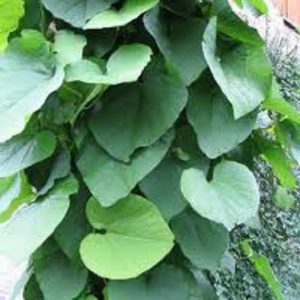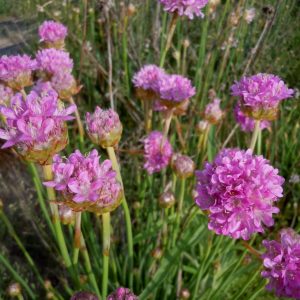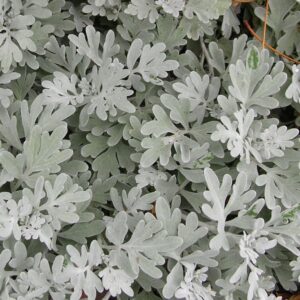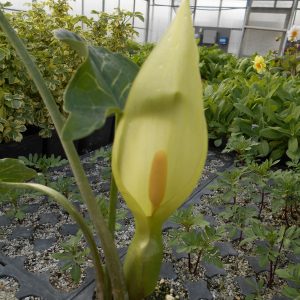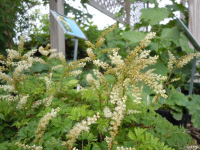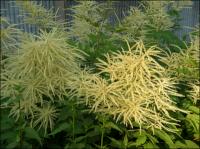Perennials & Biennials
Showing 49–56 of 485 results
-
Aristolochia durior syn. A. macrophylla, A sipho Dutchman’s pipe, Birthwort Z 4-8
Yellow, mottled brown flowers like Meerschaum pipes in May – June, mostly grown for heart-shaped leaves on this vigorous climber (climbs by twining). Perfect for creating a screen on pergolas, arbors and fences.
OUT OF STOCK
Yellow, mottled brown flowers like Meerschaum pipes in May – June, mostly grown for heart-shaped leaves on this vigorous climber (climbs by twining). Perfect for creating a screen on pergolas, arbors and fences.
Size: 20-30’ x 2’ at ground, 20’ on top.
Care: sun to shade (one of few vines for shade) in moist well-drained to moist soil. Prune to encourage branching.
Native: Maine to Georgia, west to KS.
Wildlife Value: sole host for the Pipevine swallowtail butterflyAristolochia is Greek for easing childbirth. Cherokee applied decoction of root for swollen legs & feet. Collected by Colonial nurseryman John Bartram and sent to England in 1763. Sold in America’s 1st plant catalog, Bartram’s Broadside, 1783. In Colonial and Victorian gardens, popular vine to create privacy and shade
-
Armeria maritima Thrift, Sea pink Z 3-10
Petite pink balls from May to June atop grass-like foliage
Petite pink balls from May to June atop grass-like foliage
Size: 8” x 12”
Care: full sun, well-drained, moderately fertile soil
Native: North Atlantic coastsKnown to grow in the late Glacial period – around 10,000 BC. Common cottage garden flower since the reign of Queen Elizabeth 1st, 16th century. A favorite plant for knot gardens.
-
Armeria pseudoarmeria syn. A. formosa syn. A. latifolia, A. alpina Alpine thrift, Giant thrift Z 5-7
Carmine-pink balls atop stems and taller than grass-like foliage flowering in June and sporadically all summer
OUT OF STOCK
Carmine-pink balls atop stems and taller than grass-like foliage flowering in June and sporadically all summer
Size: 12” x 8”
Care: full sun in well-drained soil, heat and drought tolerant
Native: So. EuropeIn gardens since 1740. Per Wm Robinson this plant: “one of the best hardy flowers from southern Europe and should be in every collection.”
-
Artemisia frigida Prairie sagewort, Silky wormwood Z 3-10
Erect stems bear silvery-white, finely-divided foliage. Leaves smell like camphor. Inconspicuous yellow flowers bloom in summer.
OUT OF STOCK – EMAIL FOR AVAILABILITY
Erect stems bear silvery-white, finely-divided foliage. Leaves smell like camphor. Inconspicuous yellow flowers bloom in summer.
Size: 6-18” x 12-18”
Care: sun in well-drained soil. Drought tolerant.
Native: all North America except the SE, CA and OR, Wisconsin native
Wildlife Value: source of nesting material for native bees, food for caterpillars of several butterflies & moths
Awards: Royal Horticultural Society Award of Garden MeritNative Americans used this Artemisia to preserve meat, feed horses, repel insects, to remedy toothache, headache, coughing, lung ailments, heartburn, and colds. Indians in Great Basin used it in ceremonies. Chippewa made a decoction of root for convulsions. For the Lakota this was “women’s medicine” with an infusion helping regulate menstrual periods and induce contractions in pregnancy.
Meriwether Lewis collected this along the Missouri River in South Dakota on October 3, 1804. -
Artemisia stellerana Beach wormwood, Dusty miller Z 3-7
Intricate, embroidery-like, felty-white foliage
Grown for its intricate, embroidery-like, felty-white foliage
Can not ship to: Maryland
Size: 24” x 12”
Care: sun in moist well-drained to dry soil
Native: naturalized in North America from Massachusetts to DelawareArtemisia named for the wife of Mausolus, king of Caria, who began using another Artemisia. Miller 1768. Collected from the wild by 1842. Recommended by Gertrude Jekyll to use on the edges of gardens, 1908 L.H. Bailey (1933) described it as “attractive for its whiteness. Useful for borders.”
**LISTED AS OUT OF STOCK BECAUSE WE DO NOT SHIP THIS ITEM. IT IS AVAILABLE FOR PURCHASE AT OUR RETAIL LOCATION.
-
Arum italicum Cuckoo plant, Lords and ladies Z 5-9
“The leaves of this sort rise a foot and a half high, are very large, running out to a point; these are finely veined with white, interspersed with black spots, which, together with the fine shining green of their surface, make a pretty variety. The flowers grow near a foot high, and have long upright spaths, which are of a pale green, inclining to white; these appear the end of April, or beginning of May, and the seeds are ripe in August.” Phillip Miller’s Gardeners Dictionary, 1768. (seeds are poison)
“The leaves of this sort rise a foot and a half high, are very large, running out to a point; these are finely veined with white, interspersed with black spots, which, together with the fine shining green of their surface, make a pretty variety. The flowers grow near a foot high, and have long upright spaths, which are of a pale green, inclining to white; these appear the end of April, or beginning of May, and the seeds are ripe in August.” Phillip Miller’s Gardeners Dictionary, 1768. (seeds are poison)
Can not ship to: Maryland
Size: 10-15”x 8"
Care: Shade to part shade in moist well-drained soil
Native: Italy, Spain, Britain, and Portugal.
Awards: Royal Horticultural Society Award of Garden MeritIdentified by Pedianus Dioscordies (40 – 90) in De Materica Medica for medicinal use around 70 A.D. “Showy,” according to William Robinson (1933.)
-
Aruncus aethusifolius Dwarf goat’s beard Z 3-8
You know the fireworks they display at the end of the night, with light bursting every direction from a center? These flowers resemble a tiny version of that, emerging in spring and early summer above a compact mound of fern-like foliage
You know the fireworks they display at the end of the night, with light bursting every direction from a center? These flowers resemble a tiny version of that, emerging in spring and early summer above a compact mound of fern-like foliage. Good foil for solid, paddle-like leaves of Bergenia.
Size: 10" x 12-18"
Care: part shade to shade in moist to well-drained soil
Native: Korea
Awards: Elizabeth Carey Miller Botanical Garden Great Plant Pick.Described in 1912 by Japanese botanist who explored Korea for plants, Takenoshin Nakai (1882-1952)
-
Aruncus dioicus syn. Spiraea aruncus, Aruncus sylvester Goat’s beard Z 3-7
Bold cream-colored arching plumes in early to mid-summer, light up shady corners.
Bold cream-colored arching plumes in early to mid-summer, light up shady corners.
Size: 5-6' x 4'
Care: part to full shade, moist to moist well-drained soil
Native: Europe, E. Siberia, E. North America
Awards: Royal Horticultural Society Award of Garden MeritGrown by Tradescant in England by 1633. Sold in America’s 1st plant catalog, Bartram’s Broadside, 1783. In 1870 William Robinson recommended growing the plant for naturalization. Robinson described it as: “beautiful in foliage and habit as well as flower…flowers are freely produced in summer in large gracefully-drooping plumes.”

